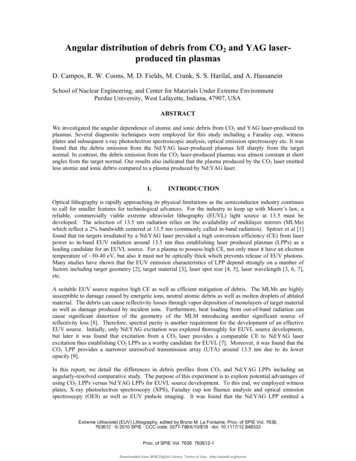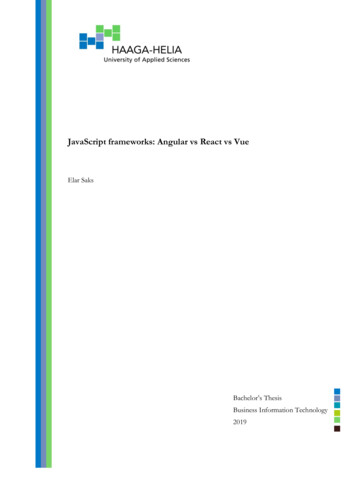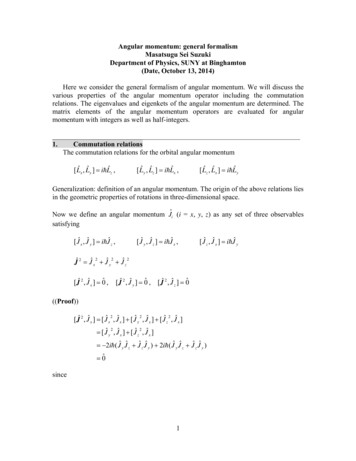
Transcription
Angular distribution of debris from CO2 and YAG laserproduced tin plasmasD. Campos, R. W. Coons, M. D. Fields, M. Crank, S. S. Harilal, and A. HassaneinSchool of Nuclear Engineering, and Center for Materials Under Extreme EnvironmentPurdue University, West Lafayette, Indiana, 47907, USAABSTRACTWe investigated the angular dependence of atomic and ionic debris from CO2 and YAG laser-produced tinplasmas. Several diagnostic techniques were employed for this study including a Faraday cup, witnessplates and subsequent x-ray photoelectron spectroscopic analysis, optical emission spectroscopy etc. It wasfound that the debris emission from the Nd:YAG laser-produced plasmas fell sharply from the targetnormal. In contrast, the debris emission from the CO2 laser-produced plasmas was almost constant at shortangles from the target normal. Our results also indicated that the plasma produced by the CO2 laser emittedless atomic and ionic debris compared to a plasma produced by Nd:YAG laser.I.INTRODUCTIONOptical lithography is rapidly approaching its physical limitations as the semiconductor industry continuesto call for smaller features for technological advances. For the industry to keep up with Moore’s law, areliable, commercially viable extreme ultraviolet lithography (EUVL) light source at 13.5 must bedeveloped. The selection of 13.5 nm radiation relies on the availability of multilayer mirrors (MLMs)which reflect a 2% bandwidth centered at 13.5 nm (commonly called in-band radiation). Spitzer et al [1]found that tin targets irradiated by a Nd:YAG laser provided a high conversion efficiency (CE) from laserpower to in-band EUV radiation around 13.5 nm thus establishing laser produced plasmas (LPPs) as aleading candidate for an EUVL source. For a plasma to possess high CE, not only must it have an electrontemperature of 30-40 eV, but also it must not be optically thick which prevents release of EUV photons.Many studies have shown that the EUV emission characteristics of LPP depend strongly on a number offactors including target geometry [2], target material [3], laser spot size [4, 5], laser wavelength [3, 6, 7],etc.A suitable EUV source requires high CE as well as efficient mitigation of debris. The MLMs are highlysusceptible to damage caused by energetic ions, neutral atomic debris as well as molten droplets of ablatedmaterial. The debris can cause reflectivity losses through vapor deposition of monolayers of target materialas well as damage produced by incident ions. Furthermore, heat loading from out-of-band radiation cancause significant distortion of the geometry of the MLM introducing another significant source ofreflectivity loss [8]. Therefore, spectral purity is another requirement for the development of an effectiveEUV source. Initially, only Nd:YAG excitation was explored thoroughly for EUVL source development,but later it was found that excitation from a CO2 laser provides a comparable CE to Nd:YAG laserexcitation thus establishing CO2 LPPs as a worthy candidate for EUVL [7]. Moreover, it was found that theCO2 LPP provides a narrower unresolved transmission array (UTA) around 13.5 nm due to its loweropacity [9].In this report, we detail the differences in debris profiles from CO2 and Nd:YAG LPPs including anangularly-resolved comparative study. The purpose of this experiment is to explore potential advantages ofusing CO2 LPPs versus Nd:YAG LPPs for EUVL source development. To this end, we employed witnessplates, X-ray photoelectron spectroscopy (XPS), Faraday cup ion fluence analysis and optical emissionspectroscopy (OES) as well as EUV pinhole imaging. It was found that the Nd:YAG LPP emitted aExtreme Ultraviolet (EUV) Lithography, edited by Bruno M. La Fontaine, Proc. of SPIE Vol. 7636,763612 · 2010 SPIE · CCC code: 0277-786X/10/ 18 · doi: 10.1117/12.848333Proc. of SPIE Vol. 7636 763612-1Downloaded from SPIE Digital Library Terms of Use: http://spiedl.org/terms
significantly greater amount of ionic debris per laser pulse than the CO2 LPP. A significant difference inthe angular distribution of atomic and ionic debris was also observed.II.EXPERIMENTAL SETUPA schematic of the experimental setup is given in figure 1. For producing plasmas, the radiation from atransversely excited atmospheric CO2 laser (10.6 μm 30 ns FWHM) and from a Nd:YAG laser (1.06 μm 8ns FWHM) was focused onto a planar tin slab mounted on a servo-motor controlled XYZ translation stagegiving high precision of movement in all 3 directions. The mirror used to divert the 1.06 µm radiation tothe chamber was placed on a flip mount for easy removal from the 10.6 μm beam’s optical path. A simpleplasma shutter device was placed in the beam path of the CO2 laser to clip the nitrogen tail of the pulses[10]. For ion analysis, the charge collecting surface of the Faraday cup was placed 17.2 cm away from thetarget at various angles from the target normal. The FC was biased using a DC voltage power supply to anoptimized voltage of -31 V to deflect incoming electrons as well as for minimizing signal noise.Figure 1: The schematic of the experimental set up. (WP, waveplate; C, polarizing cube; BD, beam dump; M, mirror;L, lens; S, substrate; FC, Faraday cup; PMT, photomultiplier tube; ICCD, intensified charge-coupled device; PTG,programmable timing generator)To conduct the studies of atomic debris, silicon witness-plates were placed at 13 cm away from the targetagain at identical angles from the target normal. For this experiment, two sets of wafers were placedaround the chamber symmetrically about the laser path to provide more data for averaging. These waferswere then transported to IMPACT for XPS analysis; a comprehensive description of this facility is locatedelsewhere [11]. A Mg Kα source emitting at 1254 eV was used for the XPS studies. The atomic fractionsare calculated based on the integrated area under the peaks in the spectra using CasaXPS. These areas areweighted according to the relative intensities of the spectral lines the details of which can be foundelsewhere [12].We employed 2D spectral imaging using a 0.5 m spectrograph equipped with an intensified charge-coupleddevice (ICCD) for characterizing the plasma. The spectrograph was equipped with three gratings of 150grooves/mm, 600 grooves/mm, and 1800 grooves/mm, with effective dispersions of 12.6 nm/mm, 3.1nm/mm, and 1.03 nm/mm respectively. A dove prism was inserted in the optical path of the image to rotateit 90º; this was done so that the image would expand axially down the spectrograph slit instead ofProc. of SPIE Vol. 7636 763612-2
transversely across it. In this way, it was possible to achieve very high spatial resolution for densitymeasurements, and it was possible to estimate the plasma density within several hundred µm of the target[13].III.RESULTS AND DISCUSSIONIn addition to requiring high CE, a viable LPP EUVL source must cause minimum damage to the MLMs.This damage results from the ions and neutrals emitted from the plasma plume and heat loading of themirror caused by out of band emission. Several methods of debris mitigation have been investigated suchas magnetic fields [14], ambient gases [15], and mass-limited targets [16]; however, for these protectiveschemes to succeed, it is essential to develop a thorough understanding of the ionic, atomic, and particulateemissions from LPPs. The chosen power densities for the experiments were 2 1011 W/cm2 and 6 109W/cm2 respectively for Nd:YAG and CO2 laser excitation. These laser intensities were chosen because theyrepresent the optimum power densities to maximize CE [5, 17]. Typical EUV emission images wereobtained using the pinhole camera and are given in figure 2. The camera integrates the EUV emission inthe 7-15 nm spectral range; hence it captures approximately the complete unresolved transmission array(UTA). The emission features show clear differences; namely, that the Nd:YAG LPP exhibits a conicalemission where as the CO2 displays a hemispherical expansion.Figure 2: The EUV pinhole images obtained from Nd:YAG and CO2 produced Sn plasmas. A combination of 50 μmpinhole and a Zr-filter were used for obtaining these images. The Nd:YAG laser spot size was 100 µm and the CO2laser spot size was 225 µm.The FC ion analysis garnered very interesting results. Typical ion profiles obtained using the FC are givenfor CO2 and Nd:YAG LPPs along with their kinetic energy profiles. It can be seen in figure 3 that the ionfluence was significantly higher for the Nd:YAG LPP compared to the CO2 LPP due to the narrower ionprofiles obtained for the CO2 LPP. However, the kinetic distribution of CO2 LPP is shifted to the higherenergy side (figure 3 inset). We constructed an angular distribution of the ionic debris from both excitationwavelengths by plotting the integrated area of the ion profiles against the angle with respect to targetnormal. This plot is given in figure 4. The wavelength effects on ion fluence are intriguing because of thesharp contrast in the angular distributions of the ionic debris. The ion flux from Nd:YAG LPP falls offrapidly away from the target normal whereas the CO2 debris does not fall off sharply until farther awayfrom the target normal.Proc. of SPIE Vol. 7636 763612-3
Figure 3: Typical ion time of flight signals measured using the FC. The kinetic energy profiles are given in the insetand calculated using the velocities obtained from the raw data. These data were obtained at 12º from the target normal.It is known that atomic particles also cause severe damage to the MLMs through deposition. Hence, weinvestigated the angular distribution of atomic debris using witness plates. Analysis of the witness plateswas carried out using XPS which provides atomic fraction data. A representative XPS spectrum is given infigure 5. Along with Sn photoelectron peaks, impurity peaks (C1s & O1s) and substrate peaks (Si 2s and2p) were also seen in the core electron spectra. The smaller peaks immediately following the O 1s peakand the C 1s peaks are satellite peaks and should be disregarded when attempting to obtain elementalinformation. The strength of the oxygen and carbon peaks is due to their extremely high relative sensitivityfactors as given in the previous reference [12]. Using the data from the other angles we were able toconstruct an angular atomic fraction profile which is given in figure 6. This figure clearly indicates thatatomic debris is significantly higher from Nd:YAG LPPs versus CO2 LPPs. The angular distribution ofatomic emission from Nd:YAG LPPs decreases rapidly away from target normal similar to the ion fluxgiven in figure 4.Figure 4: The angular distribution of ion flux obtained from FC data. For this measurement FC was positioned at 17cm from the laser focal spot.Proc. of SPIE Vol. 7636 763612-4
Figure 5: A representative XPS spectrum from 2000 CO2 laser pulses. The oxygen and carbon peaks as well as theirrespective satellite peaks can be safely neglected for the purpose of calculating the relative fractions of tin and silicon.To better understand the wavelength effects on ion and atomic flux, we estimated basic plume parametersusing spectroscopic means. The recorded spectra showed a strong presence of excited neutrals and singlyionized Sn species in the visible emission spectral region. Using Stark Broadening measurements [18], weestimated the densities of the plasmas at various spatial locations from the target surface. Typical Starkbroadened 2D spectral images of Sn at 645.4 nm are given in figure 7. The spectral images clearly showhigher spatial extension for the visible emission from the Nd:YAG LPP. The estimated values of electrondensity at 225 µm away from the target for Nd:YAG and CO2 produced plasmas are 7.2 1017 cm-3 and2.7 1017 cm-3 respectively and these values decay to 1.0 1017 cm-3 and 0.29 1017 cm-3 at 1 mm fromthe target. It should be mentioned that the above given values are time-integrated over 2 μs starting fromonset of plasma formation. Interferometry studies [5, 19] showed that the plasma reached the criticaldensities of the excitation beams ( 1021 cm-3 for 1.06 µm and 1019 cm-3 for 10.6 µm) during peaks of therespective laser pulses. These data illuminate a key difference between CO2 and Nd:YAG LPPs.03oIUu20IFigure 6: The atomic fractions of Nd:YAG and CO2 debris from XPS analysis are given in this figure. The atomicfractions for CO2 were divided by 2.5 because it was fired 2.5 more times (1750 shots) than the Nd:YAG (700 shots)for obtaining the results.Proc. of SPIE Vol. 7636 763612-5
Figure 7: Typical Stark broadened profiles of Sn obtained at 645.4 nm using 2D spectral imagingThe greater flux of atomic and ionic debris emitted by the Nd:YAG LPP in comparison with CO2 plasma iscaused by the disparity in initial densities of the plasmas. A major source of lower-charged ions andneutrals in a LPP, especially at extended regions and at later times, can be the result of collisional threebody recombination. The relation between three-body recombination rate and the density of the plasma isgiven by [20]Rcα Z 3 ln Z 2 1 Te 9 / 2 ne2 ni(1)where Z is the charge state, Te is the electron temperature and ne and ni are the electron and ion densitiesrespectively. Equation 1 shows that three-body recombination has an ne2 dependence and the higherdensity in the case of the Nd:YAG LPP may indeed fuel a higher rate of three-body recombination bothnear to and far away from the target. Hence, one can expect larger spatial extension of the various emittingspecies (as seen in figure 7) in the visible region for the Nd:YAG LPP. More experimental work isrequired to verify this interpretation.Although the CO2 LPP ions have narrower temporal profiles, they are shifted to the higher energy side incomparison with YAG LPP ion profiles. The lower rate of three-body recombination preserves the highercharge-states of ions emitted from the CO2 LPP leading to a narrower kinetic energy distribution. It shouldbe remembered that a FC signal contains all charge-states of ions emanating from the plasma. Thevelocities of ions emitted from LPPs are governed by space-charge effects created by electrons that leavethe target at extremely high velocity and drag the positively-charged ions in their wake. It is also knownthat because of space-charge effects highly charged ions move much faster. This may explain the upwardshift in kinetic energy for the CO2 LPP.We also believe that the difference in initial densities of the plasma may play a major role in obtaining thecontrasting angular profiles of atomic and ionic debris. It is reported that the angular distribution of ionicdebris emission is proportional to a cos n (θ) function where n depends on the charge state and θ is theangle from the target normal [21]. The angular dependence of ionic emission from the Nd:YAG LPP isfound to follow a first-order cos n function. As the recombination processes occur, the ionic angular spreadis expected to increase; however, the plasma ions continue to propagate in a generally forward direction.This results in significantly lower ion and atomic flux farther away from the target normal. For the CO2LPP, the low initial density results not only in the production of significantly less ions, but also allowsmore the highly-charged ions to escape from the recombination effects. This results in the production ofsignificantly less neutral debris and thus, the lower amount of deposition on the witness plates.Proc. of SPIE Vol. 7636 763612-6
Finally, the difference in initial densities and resultant disparity in the rates of recombination is what causesthe marked difference in EUV emission profiles for the Nd:YAG and CO2 LPPs. As shown in figure 2, theEUV image obtained from the Nd:YAG LPP shows a conical emission where as the CO2 LPP shows ahemispherical expansion. It is clear from figure 2 that the aspect ratio of the Nd:YAG LPP is considerablyhigher than the CO2 LPP. The major species that contribute to in-band emission are Sn9 - Sn13 , andlower-charged ions contribute to the UTA in the longer wavelength side of the out-of-band region [9]. Itwas previously noticed that the UTA of the CO2 LPP was spectrally narrower compared to the Nd:YAGplasma [5, 16]. The emission from the extended region of cone in a YAG LPP results from the presence oflower-charged ions contributed by enhanced three-body recombination.IV. CONCLUSIONSWe compared the angular distribution of atomic and ionic emission from Sn plasmas produced by Nd:YAGand CO2 lasers. We observed a large disparity in both the amount of debris emission from the plasmas, andalso the angular distributions of the various debris species. The forward-centric angular distribution of theNd:YAG LPP atomic and ionic debris is due to the significantly higher rate of three-body recombinationand thus the enhanced production of lower-charged ions and neutral species. The lower density of the CO2LPP leads to a smaller quantity overall ionic debris and due to the lower rate of three-body recombinationsignificantly less neutral debris. While the kinetic energy distribution is shifted to higher energy for theCO2 LPP, the distribution itself is much narrower, again, due preservation of highly-charged ionic speciesand may be due to a significantly lower recombination rate. Finally, this high rate of three-bodyrecombination present in the Nd:YAG LPP likely is the cause of its further spatial extension of both visibleand EUV emission.ACKNOWLEDGEMENTSThis work was partially funded by the College of Engineering, Purdue 0][11]R. C. Spitzer, R. L. Kauffman, T. Orzechowski et al., “Soft X-ray production from laser produced plasmasfor lithography applications,” Journal of Vacuum Science & Technology B, 11(6), 2986-2989 (1993).Y. Ueno, G. Soumagne, A. Sumitani et al., “Enhancement of extreme ultraviolet emission from a CO2 laserproduced Sn plasma using a cavity target,” Applied Physics Letters, 91(23), 3 (2007).A. Nagano, T. Mochizuki, S. Miyamoto et al., “Laser wavelength dependence of extreme ultraviolet light andparticle emissions from laser-produced lithium plasmas,” Applied Physics Letters, 93(9), (2008).S. S. Harilal, “Influence of spot size on propagation dynamics of laser-produced Sn plasma,” Journal ofApplied Physics, 103, 123306 (2007).S. S. Harilal, R. W. Coons, P. Hough et al., “Influence of spot size on extreme ultraviolet efficiency of laserproduced Sn plasmas,” Applied Physics Letters, 95, 221501 (2009).A. Takahashi, D. Nakamura, K. Tamaru et al., “Emission characteristics of debris from CO2 and Nd : YAGlaser-produced tin plasmas for extreme ultraviolet lithography light source,” Applied Physics B-Lasers andOptics, 92(1), 73-77 (2008).H. Tanaka, A. Matsumoto, K. Akinaga et al., “Comparative study on emission characteristics of extremeultraviolet radiation from CO2 and Nd : YAG laser-produced tin plasmas,” Applied Physics Letters, 87(4), 3(2005).T. Feigl, S. Yulin, T. Kuhlmann et al., “Damage resistant and low stress EUV multilayer mirrors,” JapaneseJournal of Applied Physics Part 1-Regular Papers Short Notes & Review Papers, 41(6B), 4082-4085 (2002).J. White, P. Dunne, P. Hayden et al., “Optimizing 13.5 nm laser-produced tin plasma emission as a functionof laser wavelength,” Applied Physics Letters, 90(18), 181502 (2007).N. Hurst, and S. S. Harilal, “Pulse shaping of transversely excited atmospheric CO2 laser using a simpleplasma shutter,” Review of Scientific Instrumentation, 80, 035101 (2009).J. P. Allain, M. Nieto, M. R. Hendricks et al., “IMPACT: A facility to study the interaction of low-energyintense particle beams with dynamic heterogeneous surfaces,” Review of Scientific Instruments, 78(11),(2007).Proc. of SPIE Vol. 7636 763612-7
[12][13][14][15][16][17][18][19][20][21]M. P. Seah, [Quantification in AES and XPS] The Scottish Universities Summer School in Physics, GreatYarmouth, Norfolk, 1 (1993).J. Siegel, G. Epurescu, A. Perea et al., “Temporally and spectrally resolved imaging of laser-inducedplasmas,” Optics Letters, 29(19), 2228-2230 (2004).S. S. Harilal, B. O'Shay, Y. Tao et al., “Ion debris mitigation from tin plasma using ambient gas, magneticfield and combined effects,” Applied Physics B-Lasers and Optics, 86(3), 547-553 (2007).S. S. Harilal, B. O'Shay, Y. Z. Tao et al., “Ambient gas effects on the dynamics of laser-produced tin plumeexpansion,” Journal of Applied Physics, 99(8), (2006).S. S. Harilal, B. O'Shay, M. S. Tillack et al., “Spectral control of emissions from tin doped targets forextreme ultraviolet lithography,” Journal of Physics D-Applied Physics, 39(3), 484-487 (2006).A. Hassanein, V. Sizyuk, T. Sizyuk et al., “Effects of Plasma Spatial Profile on Conversion efficiency ofLaser-Produced Plasma Sources for EUV lithography,” J. Micro/Nanolith. MEMS MOEMS, 8(4), 041503(2009).S. S. Harilal, B. O'Shay, M. S. Tillack et al., “Spectroscopic Characterization of laser produced tin plasma,”Journal of Applied Physics, 98(1), 013306 (2005).Y. Tao, M. S. Tillack, S. S. Harilal et al., “Investigations on the interaction of a laser pulse with a preformedGaussian Sn plume for an extreme ultraviolet lithography source,” Journal of Applied Physics, 101, 023305(2007).P. T. Rumsby, and J. W. M. Paul, “Temperature and density of an expanding laser-produced plasma,” PlasmaPhysics and Controlled Fusion, 16(3), 247-260 (1974).A. Thum-Jager, and K. Rohr, “Angular emission distributions of neutrals and ions in laser ablated particlebeams,” Journal of Physics D-Applied Physics, 32, 2827-2831 (1999).Proc. of SPIE Vol. 7636 763612-8
for CO 2 and Nd:YAG LPPs along with their kinetic energy profiles. It can be seen in figure 3 that the ion fluence was significantly higher for the Nd:YAG LPP compared to the CO 2 LPP due to the narrower ion profiles obtained for the CO2 LPP. However, the kinetic distribution of CO 2 LPP is shifted to the higher energy side (figure 3 inset).











